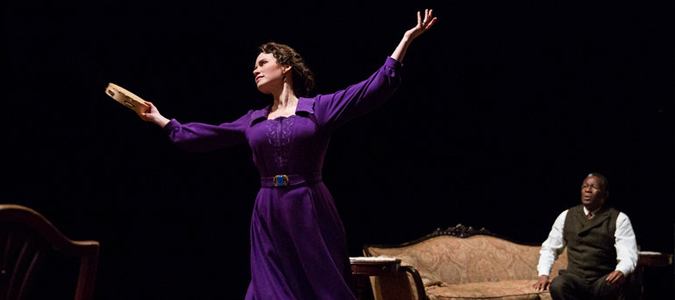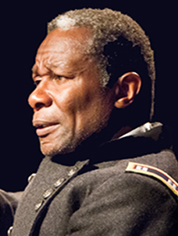

A Doll’s House & The Father
Opening Night: May 25, 2016
Closing: June 12, 2016
Theater: Polonsky Shakespeare Center
Drama Desk Award winner Maggie Lacey (Horton Foote’s The Orphans’ Home Cycle at Signature Theatre) and John Douglas Thompson, returning to TFANA after his groundbreaking performance in Tamburlaine the Great (Drama Desk and Obie Awards), star in two provocative dramas about marriage. Ibsen’s A Doll’s House adapted by Thornton Wilder, which premiered on Broadway in 1937, plays alongside August Strindberg’s The Father, in a new version in English by Scottish author David Greig (Strindberg’s Creditors at BAM) commissioned by TFANA. Writing The Father in response to A Doll’s House, Strindberg offers his own startling vision of marriage and the battle of the sexes. TFANA Associate Artistic Director Arin Arbus (King Lear) stages both plays performed for the first time in rotating repertory.
BUY TICKETSREAD THE REVIEWS:
May 25, 2016
A noise of primal desperation emanates from each of the two suspenseful dramas that have been resonantly paired in repertory by Theater for a New Audience. They are Ibsen’s “A Doll’s House” and Strindberg’s “The Father.” And there comes a moment about halfway through both productions when a solitary soul is heard gasping as if her last breath were at hand. It’s the sound of a woman realizing that she is trapped. And that if she doesn’t act fast, the walls of her already claustrophobic world are going to crush her. Both women — their names are Nora (in “A Doll’s House”) and Laura (in “The Father”) — are very capably portrayed by the same actress, Maggie Lacey. Their adversaries, who are also (but of course) their husbands, are embodied by the formidable John Douglas Thompson. Since Mr. Thompson is one of the most commanding classical actors around, you would think any performer pitted against him would be doomed to defeat. But in each instance, it’s the woman who wins, though the characters’ individual routes to victory speak volumes about the differences between the rivalrous playwrights who created them. Yeah, I know. I’ve gone and spoiled the endings. (And while I’m at it, Oedipus’s wife is his mother, and Darth Vader is Luke Skywalker’s father.) But what’s most startling about Arin Arbus’s engrossing productions, which opened on Tuesday and Wednesday nights at the Polonsky Shakespeare Center in Brooklyn, isn’t their conclusions. What really awakens the senses here is the feeling of suffocation that pervades two domestic battlefields, an impression of doom woven into the fabric of a social order. Seen on its own, each production makes this achingly clear. But to see seen them in tandem is to experience two of modern theater’s most influential minds locked in fierce dialogue about the untenable position of Scandinavian wives in the late 19th century. I say Scandinavian and 19th century, but if the corset fits … There’s nothing arbitrary about the pairing of “A Doll’s House” (1879) and “The Father” (1887). The Norwegian Ibsen and the Swedish Strindberg, who was 20 years the younger, were intensely aware of each other’s work. Ibsen even kept a portrait of Strindberg above his desk to gall him into creativity, while Strindberg was infuriated by Ibsen’s celebrity. Continue reading the main story FROM OUR ADVERTISERS Indeed, “The Father” was written as a retort to “A Doll’s House,” which Strindberg described as “swinery,” filled with logical potholes and tendentious argument. He also felt that Ibsen had grossly weighted his play in the woman’s favor. Or to quote the title character in “The Father,” as newly adapted by the Scottish playwright David Greig, on the subject of the dead patriarch in another Ibsen play, “Ghosts”: “Watching it, I couldn’t help but wonder what Mr. Alving might say if only he could claw his way out of the coffin. So many ex-husbands cold in their graves, so many women telling their tales.” Those lines are delivered by Mr. Thompson late in “The Father,” and by that time, his character, the Captain, has just about reached the breaking point. During the previous hour, we have watched the Captain’s wife, Laura — with whom he’s been fighting over the education of their daughter, Bertha (Kimber Monroe) — systematically undermine her husband’s well-being. She has planted in his mind the toxic suspicion that Bertha might not be his biological child. Given Strindberg’s reputation as a misogynist — and Mr. Thompson’s power in conveying raw torment — you might assume that your sympathies would lie entirely with the Captain. But Ms. Arbus’s interpretation and Ms. Lacey’s performance help insure that the argument here is by no means one-sided. If Laura is compelled to destroy her husband, it’s because she has effectively been his prisoner for so long. Or as she says, in rueful triumph: “I wasn’t trying to hurt you. I was only trying to breathe.” With some softening, that declaration could be spoken by the infantilized Nora to her husband, Thorwald (Mr. Thompson) at the end of “A Doll’s House,” when she comes to the realization that her seemingly happy marriage has been a lie. But it is to the credit of this interpretation, which uses Thornton Wilder’s 1937 version, that you feel not only for the painfully enlightened wife but also for the bewildered husband in torment. Ms. Arbus, whose earlier work for Theater for a New Audience includes “Othello” and “Macbeth” with Mr. Thompson, is a refreshingly levelheaded director. Her first objectives are clarity and accessibility rather than sensationalism. When she did “King Lear” here last year, she presented Shakespeare’s violently divided royal clan as the dysfunctional family next door. These twinned productions of Strindberg and Ibsen maintain a similarly low hysteria quotient (or as low as Strindberg allows), without sacrificing the plays’ anxious and compelling momentum. Using a solid doubled cast that includes Nigel Gore, Jesse J. Perez, Linda Powell and Laurie Kennedy (who’s marvelous as the fretful nanny in “The Father”), Ms. Arbus makes sure that we can hear — but really hear — what everyone in each play is saying. Ms. Lacey’s ostensible ordinariness (she made her Broadway debut as Emily in “Our Town” in 2002) always makes her easy to identify with. She is more at ease as Nora, whom she endows with an innate shrewdness, but her calm, matter-of-fact portrayal of Laura keeps us from seeing the character as a castrating witch; we know where this woman’s coming from. Mr. Thompson, whose presence always reads large, is hardly a natural choice for the small-minded Thorwald. But for that very reason, the character’s egotism has seldom seemed so daunting. His Captain in “The Father” is, in a word, brilliant, an exact and devastating portrait of one man’s inevitable collapse that brings to mind Mr. Thompson’s thrilling portrayal of “Othello.” This was the first time that I have read or seen “The Father” that “Othello” came so specifically to mind. That’s what I love about Ms. Arbus as a director: It’s like having a dream teacher at your elbow as you navigate difficult classics, one who leads you into insights without pushing. With these productions, she lets us see how two literary geniuses dealt with one subject, to notice the similarities as well as the differences, and to appreciate the qualifying detail used to draw characters often remembered as monolithic. Can you identify the writer of the following? “There are two kinds of spiritual laws and two kinds of consciences — one for men and one for women. They do not understand each other, but in the practical matters of life women are judged by men’s law, as if they were not women, but men.” That was Ibsen, speaking of “A Doll’s House” in a letter from 1878. But after seeing Ms. Arbus’s double feature, you may be excused for thinking that Strindberg might written exactly the same words.
READ THE REVIEW


















